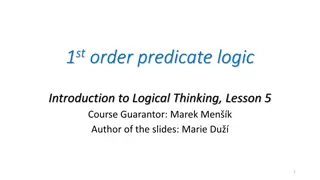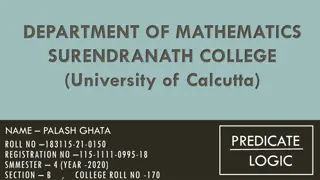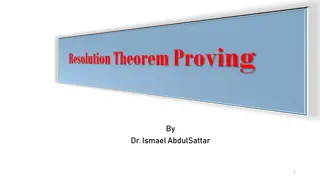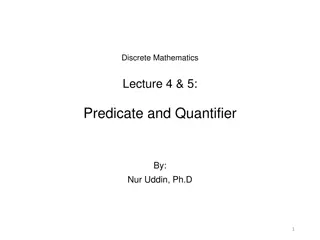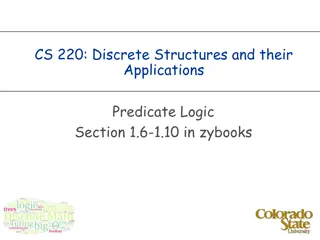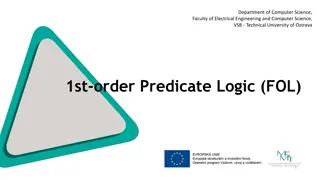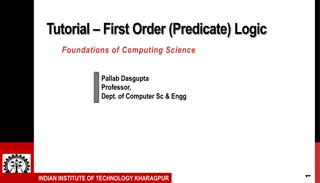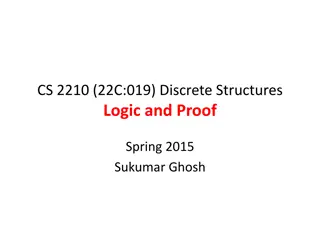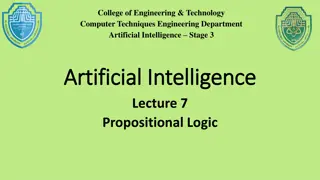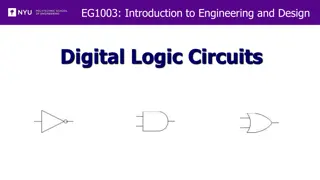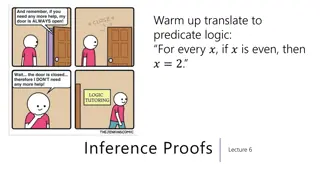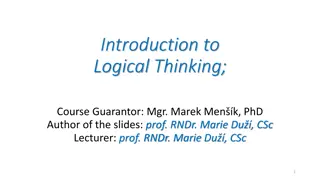Understanding Predicate Logic in Artificial Intelligence
In the world of artificial intelligence, predicate logic plays a crucial role in representing simple facts. It involves syntax, semantics, and inference procedures to determine the truth value of statements. Real-world facts are represented using propositions in logic, allowing for structured knowledge representation. Utilizing first-order predicate logic enhances the ability to capture relationships between entities, moving beyond the limitations of propositional logic.
Download Presentation

Please find below an Image/Link to download the presentation.
The content on the website is provided AS IS for your information and personal use only. It may not be sold, licensed, or shared on other websites without obtaining consent from the author. Download presentation by click this link. If you encounter any issues during the download, it is possible that the publisher has removed the file from their server.
E N D
Presentation Transcript
ARTIFICIAL INTELLIGENCE S.MANIMOZHI ASSISTANT PROFESSOR, DEPARTMENT OF CA BON SECOURS COLLEGE FOR WOMEN, THANJAVUR
Chapter 5: Using Predicate Logic Representing simple facts in Logic Representing Instance and Isa relationships Slide 1
Using Predicate Logic Logic Logic is concerned with the truth of statements about the world. Generally each statement is either TRUE or FALSE. Logic includes :Syntax , Semantics and Inference Procedure. Syntax : Specifies the symbols in the language about how they can be co mbined to form sentences. The facts about the world are repre sented as sentences in logic. Slide 2
Using Predicate Logic Semantic : Specifies how to assign a truth value to a sentence based on its meaning in the world. It Specifies what facts a sentence refers to. A fact is a claim about the world, and it may be TRUE or FALSE. Inference Procedure : Specifies methods for computing new sentences from the existing sentences Slide 2 .
Representing Simple Facts in Logic Using propositional logic Real-world facts are represented as logical propositions wr itten as well-formed formulas (wff s) Example 1: It is raining RAINING It is sunny SUNNY It is Windy WINDY RAINING SUNNY If it is raining, then it is notsunny
Representing Simple Facts in Logic Example 2: Socrates is a man SOCRATESMAN Plato is a man PLATOMAN All men are mortal MORTALMAN => Since the assertions are separate, it is not possible to dra w any conclusion about similarities between Socrates and Pl ato. Slide 6
Representing Simple Facts in Logic It would be much better to represent these facts as Socrates is a man man(socrates) Plato is a man man(plato) All men are mortal mortalman This fails to capture the relationship between any individual being individual being a mortal. Therefore it is necessary to move to first order predicate logic as a way of representing knowledge because it permits representation o represented in prepositional logi c. In predicate logic, real world facts are represented as statements written as wff s a man and that f things that cannot reasonably be . Slide 5
Representing Simple Facts in Logic Q Propositional logic vs. predicate logic Using propositional logic Theorem proving is decidable Cannot represent objects and quantification Using predicate logic Can represent objects and quantification Theorem proving is semi-decidable Slide8
Representing Simple Facts in Logic Consider the following set of sentences. 1. Marcus was a man. 2. Marcus was a Pompeian. 3. All Pompeians were Romans. 4. Caesar was a ruler. 5. All Romans were either loyal to Caesar or hated him. 6. Every one is loyal to someone. 7. People only try to assassinate rulers they are not loyal to. 8. Marcus tried to assassinate Caesar Slide9
Representing Simple Facts in Logic 1. Marcus was a man. man(Mar cus) 2. Marcus was a Pompeian. Po mpeian(Marcus) 3.All Pompeians were Romans. x: Pompeian(x) Roman(x) 4. Caesar was a ruler. ruler(Cae sar) Slide10
Representing Simple Facts in Logic 5. All Romans were either loyal to Caesar or hated him. In English the word or means the logical inclusive-or and sometimes means the logical exclusive-or(XOR) inclusive-or x: Roman(x) loyalto(x, Caesar) hate(x, Caesar) exclusive-or (XOR) x: Roman(x) ( loyalto(x, Caesar) hate(x, Caesar)) (loyalto(x, Caesar) hate(x, Caesar)) Slide11
Representing Simple Facts in Logic 6.Every one is loyal to someone. x y: loyalto(x, y) 7. People only try to assassinate rulers they are not loyal to. x: y: person(x) ruler(y) tryassassinate(x, y) loyalto(x, y) 8. Marcus tried to assassinate Caesar. tryassassinate( Marcus, Caesar) Slide12
Representing Simple Facts in Logic To answer the question Was Marcus loyal to Caesar? To produce a formal proof , reasoning backward from th e desired goal loyalto(Marcus, Caesar) To prove the goal, rules of inference are to be used to trans form into another goal that in turn be transformed and s o on, until there are no insatisfied goals remaining. Slide13
Representing Simple Facts in Logic This attempt fails , since there is no way to satisfy the goal perso n(Marcus)with the statements available. The problem is although its known that Marcus was a man there is no way to conclude it. Therefore another representation is added namely Slide14
Representing Simple Facts in Logic 9.All men are people x:man(x) person(x) This satisfies the last goal and produce a proof that Marcus w as not loyal to ceasar. Three important issues to be addressed in this process of converting English sentences to logical statements and the n using these statements to deduce new ones. Many English sentences are ambiguous. Choosing the corre ct interpretation may be difficult. There is often a choice of how to represent knowledge Obvious information may be necessary for reasoning Slide 13
Representing Instance & IsaRelationships Attributes IsA and Instance support property inheritance and play important role in knowledge representation. The ways these two attributes "instance" and "isa", are logically expresse d are shown in the example below : Example : A simple sentence like "Joe is a musician" Here "is a" (called IsA) is a way of expressing what logically is called a class-instance relationship between the su "Joe" and "musician". "Joe" is an instance of the class of things called "musician". " Joe" plays the role of instance, "musician" plays the role of class in that sentence. Note : In such a sentence, while for a human there is no con fusion, but for computers each relationship have to be defined explicitly. bjects represented by the terms Slide 14
Representing Instance & IsaRelationships The first part of the figure contains the representations, in which the class membership is represented with unary predicates, corresponding to a class. Asserting that p(x) is true is equi valent to asserting that X is an instance of p. The second part uses the instance predicate explicitly. It is a b inary one, whose first argument is an object and whose second argument is a class to which the object belongs. The implicatio statement 3 states that object is an instance of the sub pompeian then it is an instance of the superclass Roman. each n rule in class Slide18
Representing Instance & IsaRelationships The third part contains representations that use both the instan ce and isa predicates explicitly. Use of isa simplifies the repres entation of sentence 3 but requires one additional axiom.It desc ribes how an instance relation and an isa relation combined to instance relation. derive a new Slide19





